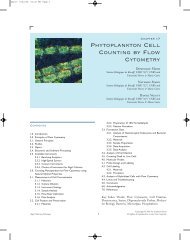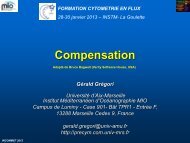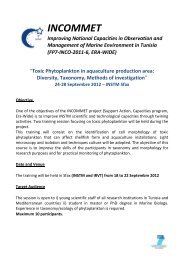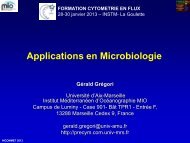Eukaryotic Picoplankton in Surface Oceans - incommet
Eukaryotic Picoplankton in Surface Oceans - incommet
Eukaryotic Picoplankton in Surface Oceans - incommet
You also want an ePaper? Increase the reach of your titles
YUMPU automatically turns print PDFs into web optimized ePapers that Google loves.
Annu. Rev. Microbiol. 2011.65:91-110. Downloaded from www.annualreviews.org<br />
by CSIC - Consejo Superior de Investigaciones Cientificas on 09/27/11. For personal use only.<br />
Contents<br />
INTRODUCTION.................. 92<br />
BULK ECOLOGICAL ROLE. . . . . . . . 93<br />
Distribution and Cell Abundance . . . 93<br />
Contribution to Primary Production<br />
andBacterivory................. 95<br />
Other Trophic Attributes . . . . . . . . . . 95<br />
BEYOND BULK ASSEMBLAGES . . . 96<br />
Need for Molecular Approaches <strong>in</strong><br />
Diversity Studies . . . . . . . . . . . . . . . . 96<br />
Laboratory Studies with Isolated<br />
Picoeukaryotes.................. 97<br />
L<strong>in</strong>k<strong>in</strong>g Diversity and Function for<br />
Uncultured Groups . . . . . . . . . . . . . 97<br />
NAVIGATING THROUGH THE<br />
MAIN PHYLOGENETIC<br />
GROUPS......................... 98<br />
Alveolates:MALV................. 98<br />
Stramenopiles: Chrysophytes,<br />
Pelagophytes, and MAST . . . . . . . 100<br />
Rhizaria: Cercozoans and<br />
Radiolarians . . . . . . . . . . . . . . . . . . . . 100<br />
Archaeplastida: Pras<strong>in</strong>ophytes . . . . . . 100<br />
CCTH: Haptophytes, Cryptophytes,<br />
and Picobiliphytes . . . . . . . . . . . . . . 101<br />
Excavates, Opisthokonts, and<br />
Amoebozoans................... 101<br />
Overview of the Numerically<br />
Dom<strong>in</strong>ant Taxonomic Groups . . . 102<br />
SEQUENCES, POPULATIONS,<br />
ANDCOMMUNITIES........... 102<br />
Crunch<strong>in</strong>g Sequence Datasets:<br />
Estimat<strong>in</strong>g Diversity and Novelty 102<br />
Translat<strong>in</strong>g OTUs <strong>in</strong>to a<br />
TaxonomicRank............... 103<br />
Population Ecology and<br />
Biogeography................... 103<br />
Community Structure . . . . . . . . . . . . . . 105<br />
INTRODUCTION<br />
<strong>Oceans</strong> cover approximately 70% of Earth’s<br />
surface and play fundamental roles <strong>in</strong> processes<br />
that have global ecological and socioeconomic<br />
impacts (7). They are a vital component of<br />
the climate system and are suffer<strong>in</strong>g and partially<br />
attenuat<strong>in</strong>g anthropogenic global change.<br />
Life orig<strong>in</strong>ated <strong>in</strong> the oceans, which have been<br />
the ma<strong>in</strong> sites of evolution. It is no surprise<br />
that oceans harbor organisms spann<strong>in</strong>g a large<br />
range of body sizes, phylogenetic affiliations,<br />
and trophic modes (71). Photosynthesis is a<br />
critical process that allows life on Earth, and<br />
<strong>in</strong>terest<strong>in</strong>gly, half the global primary production<br />
occurs <strong>in</strong> the sea, mostly by planktonic<br />
microorganisms that account for only 0.2% of<br />
global primary producer biomass (24). This has<br />
many consequences for the function<strong>in</strong>g of mar<strong>in</strong>e<br />
ecosystems, <strong>in</strong>fluenc<strong>in</strong>g carbon and energy<br />
fluxes through organisms (food webs), affect<strong>in</strong>g<br />
carbon fluxes to deep waters (biological pump),<br />
and f<strong>in</strong>e-tun<strong>in</strong>g of all biogeochemical cycles.<br />
The recognized importance of oceans and their<br />
microbial life has promoted an expansion of microbial<br />
ecology studies fueled by novel analytical<br />
capabilities (8).<br />
Planktonic microorganisms are categorized<br />
<strong>in</strong>to classes based on size for operational purposes<br />
(78). Initially, only prokaryotes were <strong>in</strong>cluded<br />
<strong>in</strong> the smallest class (picoplankton: cells<br />
0.2 to 2 μm) and microbial eukaryotes (protists)<br />
were <strong>in</strong>cluded <strong>in</strong> the nanoplankton (2 to<br />
20 μm) or microplankton (20 to 200 μm). Picoeukaryotes<br />
known <strong>in</strong> culture at that time were<br />
not expected to be quantitatively important <strong>in</strong><br />
the sea. However, m<strong>in</strong>ute eukaryotes were soon<br />
detected by epifluorescence microscopy (23, 37)<br />
and flow cytometry (62). Picoeukaryotes are<br />
now known to be ubiquitous <strong>in</strong> surface oceans<br />
(39, 88) and form, together with prokaryotes,<br />
an ocean’s veil above which larger protists and<br />
metazoans might bloom. They exemplify the<br />
ecological success of m<strong>in</strong>iaturized cells prepared<br />
for <strong>in</strong>dependent life by keep<strong>in</strong>g only the<br />
m<strong>in</strong>imal cellular components, typically one mitochondrion,<br />
one Golgi apparatus, and optionally<br />
one chloroplast and flagellum (66).<br />
For decades, picoeukaryotes were treated as<br />
a bulk assemblage ow<strong>in</strong>g to the <strong>in</strong>ability to differentiate<br />
them (Figure 1). Pigmented cells<br />
account for a significant fraction of primary<br />
production, especially <strong>in</strong> oligotrophic conditions<br />
(46, 88), whereas colorless cells are ma<strong>in</strong>ly<br />
92 Massana








